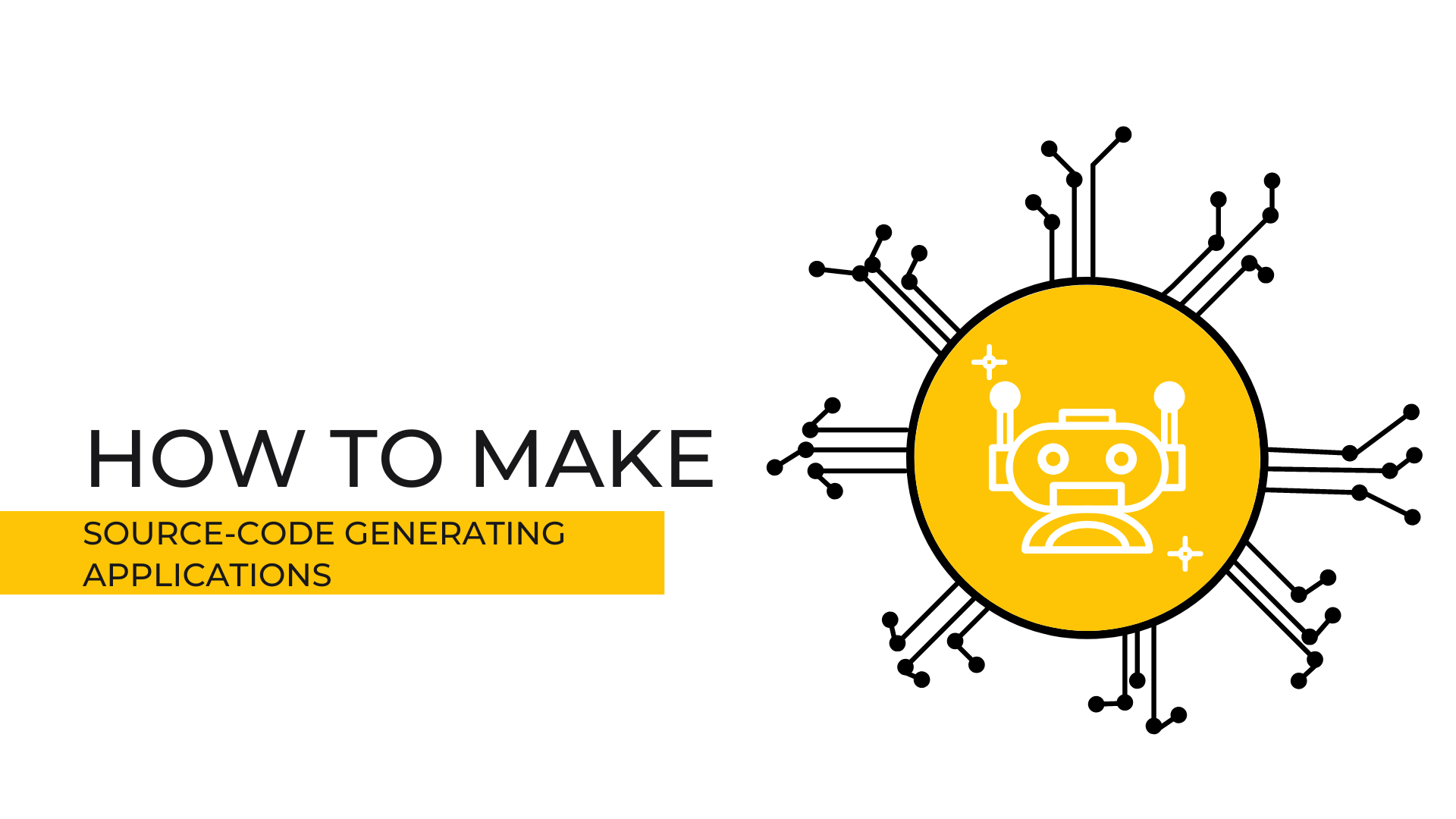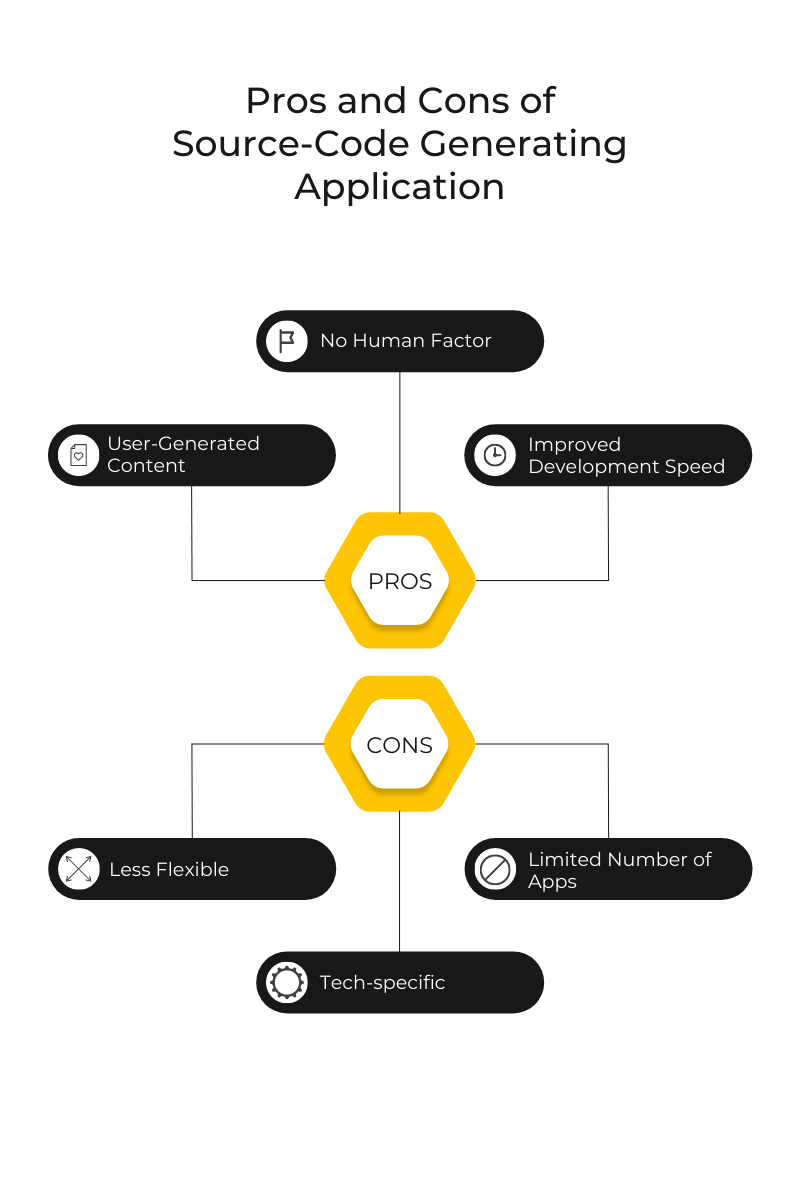Dev Tools
How to Make Source-Code Generation Applications Work?
June 30, 2023 • 591 Views • 15 min read
Tetiana Stoyko
CTO & Co-Founder

Programming languages as well as development practices and specialists have become a well-spread phenomenon in the modern era. Imagining any current product with no software development engagement is extremely hard. Most services and products are accompanied by various software solutions. Yet, is the ability to generate source code such an essential skill, that everyone should become a software engineer and learn at least coding basics?
Fortunately, the answer is no. Understanding the rising demand as well as the limited resources some people, needed for developing their own solutions, resulted in the emergence of so-called source-code generation applications or platforms. They are commonly confused with no-code or low-code apps, which is actually not correct.
Therefore, to clarify what a source-code generation app is, how it works, and the difference between automatic coding and no-code apps, let’s examine this technological solution in detail.
What is Code Generation?
To make it simple, it is a software-based approach, which allows automated code generation, meaning that instead of manual code generation by the developer, a specified program does it automatically.

However, it also doesn’t mean that it is totally independent or that such programs are capable of coding any request. As a matter of fact, such software solutions generate source code according to various templates, which were set up by the development team.
In other words, automatic coding is not an on-demand alternative to developers but rather a great development instrument, which helps software engineers to automate some routine coding tasks, if they have previously created corresponding templates.
Have a look at our cases, which are software development tools based on source-code generation software:
Automated Code Generation vs No-Code vs Low-Code
The code generator has a lot of alternative names such as automatic coding or automated programming. However, such terms as low-code and no-code have slightly different meanings and are regularly confused with code generation.
To make it simple, code generation is the process, performed by specific software. At the same time, no-code and low-code applications are playing the role of app constructors, giving their users the ability to create simple applications, having no software development experience, and avoiding hiring dedicated teams.
The first conclusion after comparing Code generation vs No-code apps is that no-code and low-code applications are using code generation under the hood. In other words, source code generation is a development approach, while no-code and low-code software are, in fact, ready-made apps.
Therefore, the next conclusion we can make, is that code generation can be used as a great development tool, which helps to simplify the work of software engineers, while the rest - are mainly user-oriented products, designed to enable the possibility to develop simple apps. Thus, we will consider code generation as a feature, instead of ready-made solutions.
What Do You Need for a Source-Code Generation?
Technologies Overview
Frankly speaking, there is a wide range of various software tools such as libraries and frameworks, which support source code generation features.
The main difference between them is the use purposes. For instance, some of them are used specifically for web development. Still, the most popular development tools are more general, allowing the development of different types of applications, supporting multiple platforms, etc.
For instance, Visual Studio, one of the most popular dev tools among software engineers, supports text transformation as an alternative code generation during development. To rephrase it, developers can create various code-based templates at first, and after they are created, software engineers are able to request for these templates via simple text commands, which will be recognized by the software itself, giving a related response.
Yet, the most well-spread practice is choosing between GraphQL vs REST. The reason for the popularity of these software solutions is the fact, that they propose impressive services for API development. Additionally, it is obvious, that both of them are supporting automated code generation options.
So, the answer to the foregoing question on what you need for source code generation - is the corresponding tech stack. As a matter of fact, not all frameworks, libraries, or other software solutions, are supporting code generation. Thus, before actually starting the development of automated code generation applications, you should choose the correct technologies. However, it is clear, that technologies are not the only required aspect.
Experience Dedicated Team
In addition to choosing technologies, it is worth making sure, that your developers are familiar with them. Apparently, in case your software development team has no experience in working with the chosen tech stack, it will be a real challenge to develop a high-quality product.
So, it is worth taking into account the developers’ experience. In case, your in-house team is not qualified enough, you may find it useful to simply outsource automated programmer development tasks.

Auto Code Generation Pros and Cons

Code Generation Advantages
So, why you might need a source-code generation app, and what are the potential pros and cons of this technology?
Apart from being a useful dev tool, which helps to significantly upscale the development environment and can become a great bonus for end-users.
User-Generated Content
For example, such apps as WordPress are commonly using this principle, giving different development tools for user-content creation. As a matter of fact, plugins and ease of use have become key features of similar application constructors, which are based on source code generation tools.
Improved Development Speed
Alternatively, you can use automatic coding for boilerplate code implementation via a single command. So, instead of coding a whole application code unit manually, developers can simply automate it with the use of a code generator tool and insert it with a single command. Yet, boilerplate code is not the only possible fragment, which can be easily automated. As was mentioned before, developers can create various templates, which relate to different application aspects. Still, the most suited code blocks are the ones, which are used regularly.
No Human Factor
Additionally, auto-generated code is handled by the program. So, it also decreases the possibility of potential bugs and mistakes. Besides, this means that the QA stage will be much easier and faster as well, due to the decreased number of steps to make.
Automated Code Generation Drawbacks
Limited Number of Apps
The first and most important challenge of auto code generation is the number of possible applications to develop.
As a matter of fact, despite all the advantages of such tools, their usage is extremely limited. Mainly, it is used for the creation of simple applications or as an additional feature to automate just a few lines of code, i.e. you won’t be able to use it as an ultimate solution when it comes to complex and complicated applications. Still, it is a useful add-on if your team will have to handle numerous repetitive code blocks.
Less Flexible
Clearly, manual coding has a more broad variety of possible results, as well as can be easily adjusted to the needs of the project or the will of the developer. At the same time, auto code generation is more paternalistic. Thus, if you are looking for a deeper and more unique approach - code generation is by far not your choice.
Tech-Specific
Eventually, code generation commonly depends on the technologies, which support such functionality. So, apart from the need to find correct solutions, which are compatible with your applications, you will also need to find developers, who are familiar with these techs.
Ultimate Feature of Source Code Generation
Summing up all the above, we found out, that automatic code generation can be used for various purposes including supportive tools for the developers, as well as the basis for no-code and low-code development approaches, allowing various users to use such apps to develop simple applications.
What we haven’t mentioned though, is the code rewriting possibility, which is a real game changer in some industries.
What is Code Rewriting?
To make it simple, this is one of the possible features, provided by various advanced code generation applications and software examples.

This feature allows automation of the “translation” process, i.e. gives developers a chance to change the basic programming language by translating it into another one. Such tools are also commonly referred to as compilers.
For instance, the Babel compiler proposes real-time compilation of older versions of JavaScript into modern ones. So, if you have an app, based on an outdated JavaScript code version, you can simply copy-paste it and gain an updated version of JavaScirpt syntax. Additionally, there are such software solutions as Project Lombok or even Scala programming language model.
Finally, code rewriting gives an opportunity not only to update the outdated legacy code but potentially allows make it possible to easily switch the basic programming language of an app into another one on demand, upscale OS emulators, or even enable real-time adjustment of an app to a new platform.
End Line
All the foregoing are just a few useful tips on how you can benefit from making a source-code generation application. At the same time, if you were looking for a short answer to the question of how to make such apps work - you need to find corresponding software and niche-experienced developers, who are familiar with such technologies and are capable of using them correctly.
For instance, as was mentioned before, our Incora team has broad experience in working with such software solutions as GraphQL and REST, which can be easily checked in our case studies. For more detail, you are always welcome to contact us and ask all your possible questions for further explanation and a dedicated individual approach.
What’s your impression after reading this?
Love it!
1
Valuable
1
Exciting
1
Unsatisfied
1
FAQ
Let us address your doubts and clarify key points from the article for better understanding.
What is a source-code generation app?
A source-code generation app is a software tool or application that automates the process of generating source code for a particular programming language or framework. It typically takes input data or specifications and produces corresponding code files, reducing the manual effort required to write repetitive or boilerplate code.
How do source-code generation apps work?
Source-code generation apps work by utilizing predefined templates, rules, or specifications to generate code. These apps often leverage techniques like parsing input files, applying transformations or rules, and combining template fragments to produce the desired code. They can be designed to handle a variety of scenarios, from generating simple code snippets to creating entire application frameworks.
Can I customize the generated code?
Yes, many source-code generation apps provide customization options. These options may include configuring coding style, naming conventions, architectural choices, or specifying additional features. Customization allows developers to align the generated code with their project's specific requirements and coding standards.
Can source-code generation apps be used with multiple programming languages?
Yes, source-code generation apps can support multiple programming languages. However, the level of support may vary depending on the specific app or framework. Some apps are designed to be language-agnostic and can generate code for various languages, while others may be specific to a particular language or framework.
Can source-code generation apps integrate with existing codebases?
Yes, many source-code generation apps are designed to integrate with existing codebases. They can generate code that seamlessly integrates with the existing project structure, dependencies, and coding standards. This allows developers to introduce code generation gradually and selectively to enhance or extend their existing codebase.
you may also like
Let’s talk!
This site uses cookies to improve your user experience. Read our Privacy Policy
Accept
Share this article